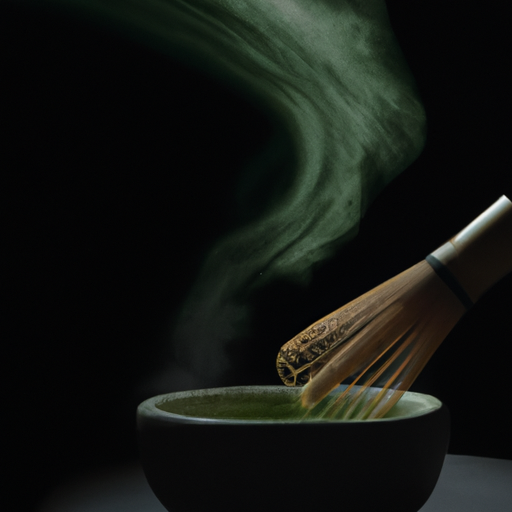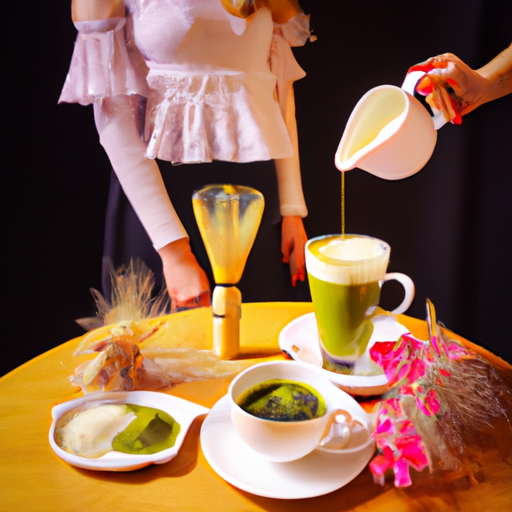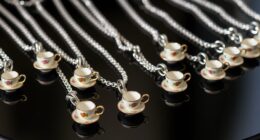As someone who loves matcha, I’ve learned that whisking matcha is an essential part of making it. It’s not only about achieving a drink that looks frothy and appealing, but the act of whisking improves the taste and health advantages of matcha.
In this article, I’ll explain why whisking matcha is important and how to do it properly to get the most out of your matcha experience.
Matcha is a type of green tea that has been ground into a fine powder. Unlike traditional green tea, where the leaves are steeped and discarded, in matcha, the entire tea leaf is consumed. This means that matcha contains a higher concentration of nutrients and antioxidants, making it a superfood in its own right.
But to fully reap the benefits of matcha, it’s important to know how to prepare it properly, and that starts with whisking. So, let’s dive into why whisking matcha is such a crucial step in the process.
Key Takeaways
- Whisking matcha enhances its flavor and health benefits, creating a frothy and smooth texture that ensures every sip is consistent and delicious.
- Using a chasen (bamboo whisk) to create a back-and-forth motion in the bowl is the traditional technique for whisking matcha.
- Whisking matcha is a crucial step in the preparation process and ensures that the powder is evenly distributed, enhancing the flavor and aroma of the tea.
- Whisked matcha has a creamy, frothy texture that cannot be replicated by other beverages, and low-quality matcha cannot compare to the rich, earthy flavors of high-quality, whisked matcha.
What is Matcha?
Ready to learn about matcha? It’s a finely ground green tea powder that’s full of antioxidants and nutrients!
Matcha cultivation is an art form that originated in Japan, where it has been a part of their culture for centuries. Matcha is made from shade-grown tea leaves, which are carefully handpicked and ground into a fine powder using traditional stone mills. The process of growing and preparing matcha requires skill and patience, and is steeped in tradition.
The history of matcha can be traced back to the Tang Dynasty in China, where it was first introduced as a medicinal beverage. It was later adopted by Buddhist monks in Japan as a way to stay alert and focused during long meditation sessions.
Today, matcha is enjoyed all over the world for its health benefits and delicious taste. Its popularity has led to the development of new recipes and ways to enjoy matcha, from lattes to desserts.
So, why is whisking matcha important? When matcha is whisked, it creates a frothy and smooth texture that enhances the flavor and aroma of the tea. It also helps to evenly distribute the powder, ensuring that every sip is consistent and delicious. Whisking matcha is a crucial step in the preparation process, and it requires a special tool called a chasen or bamboo whisk.
With the right technique and tools, whisking matcha can be a fun and rewarding experience that results in a delicious cup of tea.
Whisking Matcha: Why It’s Important
Imagine you’re creating a work of art with each swirl of your bamboo chasen, blending together the vibrant green powder and frothy water until it becomes a masterpiece of flavor and texture. Whisking matcha is more than just a technique, it’s an art form that requires patience, skill, and attention to detail.
Here’s why whisking matcha is so important:
-
Importance of texture: Whisking matcha creates a smooth, creamy texture that enhances the flavor and overall drinking experience. A well-whisked bowl of matcha should have a frothy layer on top that’s both visually appealing and delicious.
-
Importance of flavor: Whisking helps to evenly distribute the matcha powder, ensuring that every sip is packed with flavor. Without proper whisking, you could end up with clumps of powder in your drink, resulting in an uneven taste.
-
Importance of aroma: Whisking also helps to release the aroma of the matcha, which is an important aspect of the drinking experience. The aroma should be fresh and grassy, indicating that the matcha is of high quality.
-
Technique: Whisking matcha requires a specific technique that involves using a chasen (bamboo whisk) to create a back-and-forth motion in the bowl. It’s important to use the right amount of pressure and speed to create the perfect froth and ensure that all the powder is whisked evenly.
In order to perfect the art of whisking matcha, it’s important to have the right equipment. Choosing the right chasen, bowl, and other tools can make all the difference in the final product.
Choosing the Right Equipment
When it comes to whisking matcha, choosing the right equipment is crucial.
There are different types of whisks and bowls that can affect the taste and texture of your matcha.
Personally, I recommend purchasing your equipment from a reputable source to ensure quality and authenticity.
Types of whisks and bowls
To achieve the perfect frothy matcha, you’ll need a bamboo whisk and a bowl specifically designed for whisking. There are different types of whisks and bowls available in the market, each with its unique features and benefits. Here are some things to consider when choosing the right whisk and bowl for your matcha:
-
Whisk materials: Bamboo whisks are the most commonly used for matcha because they’re flexible and durable. They also create a fine froth that enhances the flavor and texture of the matcha. However, there are also electric frothers and metal whisks that can be used as alternatives.
-
Bowl shapes: Matcha bowls come in different shapes and sizes, but the most traditional ones are shallow and wide. This allows for easy whisking and helps to create a frothy consistency. Other shapes like tall and narrow bowls may be used for ceremonial matcha preparation.
When choosing your whisk and bowl, it’s important to consider your personal preferences and the type of matcha you’ll be making. A good quality whisk and bowl will help you achieve the perfect froth and enhance the overall matcha experience.
If you’re unsure where to purchase your matcha equipment, don’t worry. There are many online stores that specialize in matcha accessories, and your local tea shop may also carry them.
In the next section, we’ll explore some of the best places to purchase matcha equipment and provide tips on what to look for.
Where to purchase equipment
Finding high-quality equipment for preparing matcha can be made easier by knowing where to purchase them. In today’s digital age, online stores offer a wide variety of matcha equipment options. Some of the popular online stores that sell matcha whisks, bowls, and scoops are Amazon, Teavana, and Matcha Konomi.
These online stores have a vast selection of equipment, ranging from traditional bamboo whisks to modern electric whisks, and from ceramic bowls to glass bowls. They also offer different price points to cater to different budgets. Plus, online stores usually have detailed product descriptions and customer reviews, making it easier to compare and select the right equipment.
If you prefer to see and feel the equipment before purchasing them, physical shops are the way to go. Japanese grocery stores, tea shops, and kitchenware stores are excellent places to find matcha equipment. These shops usually carry traditional matcha equipment made in Japan, such as Chasen (bamboo whisk), Chawan (ceramic bowl), and Chashaku (bamboo scoop).
Moreover, visiting physical shops allows you to ask questions and receive recommendations from the staff, who are often knowledgeable about matcha and its preparation. Plus, you get to support local businesses while indulging in your matcha hobby.
When it comes to preparing matcha, having the right equipment is crucial. However, the quality of the matcha itself also plays a significant role. That’s why the next step is to learn about selecting quality matcha.
Selecting Quality Matcha
You’ll want to ensure that you’re selecting high-quality matcha by looking for vibrant, green color and a smooth, velvety texture. When purchasing matcha, it’s important to pay attention to the grading system. Matcha is typically classified into three grades: ceremonial, premium, and culinary. Ceremonial grade matcha is the highest quality and is meant to be consumed on its own, while premium and culinary grades are more commonly used for cooking and baking.
In addition to the grading system, taste testing can also help determine the quality of matcha. A good matcha should have a rich, umami flavor with a slight sweetness and little to no bitterness. When tasting matcha, it’s important to pay attention to the aroma, texture, and aftertaste as well. Matcha that has a stale or grassy smell, a gritty texture, or a bitter aftertaste may not be of the highest quality.
To help you better understand the different grades of matcha, take a look at this table:
| Grade | Color | Flavor Profile | Common Uses | Price Range |
|---|---|---|---|---|
| Ceremonial | Vibrant Green | Rich and Umami | Drinking on its own or in traditional tea ceremonies | $20-30 per ounce |
| Premium | Bright Green | Balanced Flavor | Culinary uses, lattes, smoothies, baking | $10-20 per ounce |
| Culinary | Dull Green/Yellow | Bitter and Earthy | Cooking and baking | $5-10 per ounce |
Now that you know how to select high-quality matcha, let’s move on to how to prepare whisked matcha.
How to Prepare Whisked Matcha
Get ready to experience the rich, velvety texture and balanced flavor profile of a perfectly prepared cup of matcha. The key to achieving this is to properly whisk your matcha.
First, it’s important to use the correct matcha ratios. For a traditional cup of matcha, use about 1 teaspoon of matcha powder to 2 ounces of hot water. However, you can adjust the ratio to your liking, depending on how strong or weak you prefer your matcha.
Next, let’s talk about frothing techniques. You can use a bamboo whisk or an electric frother to mix your matcha. To use a bamboo whisk, start by sifting your matcha powder into a bowl to remove any clumps. Then, pour hot water over the matcha and whisk it vigorously in a zig-zag motion until it becomes frothy.
If you’re using an electric frother, simply whisk the matcha and hot water together until it becomes frothy.
Now that you know how to properly prepare whisked matcha, it’s time to move on to customizing your matcha. Whether you prefer a classic matcha latte or enjoy experimenting with different flavors and ingredients, there are endless ways to customize your matcha to your liking.
So grab your matcha powder and get ready to create the perfect cup of matcha for you.
Customizing Your Matcha
Now it’s time to make your matcha truly your own by adding in your favorite flavors and ingredients. Personalized recipes are the best way to enjoy matcha at home. There are endless flavor variations and combinations that can be added to your matcha.
One way to spice up your matcha is by adding honey or agave syrup to sweeten it up. You can also add a splash of vanilla extract for a subtle aroma and flavor. Another way to customize your matcha is by adding different types of milk, such as almond milk or coconut milk, for a creamier texture. You can also experiment with different spices like cinnamon or nutmeg for a warm and cozy flavor. Don’t be afraid to try new things and create your own signature matcha recipe.
With so many options for flavor variations, you’ll never get bored with your matcha routine. Now that you’ve personalized your matcha, it’s time to reap the health benefits. Matcha is packed with antioxidants and nutrients that can boost your immune system, improve brain function, and even help you relax.
So sit back, relax, and enjoy your personalized cup of whisked matcha.
Health Benefits of Whisked Matcha
When I drink a cup of whisked matcha, I know I’m not only getting a delicious beverage, but also a host of health benefits. Matcha is packed with antioxidants and other nutrients that can help fight off disease and keep your body functioning at its best.
Additionally, the caffeine content in matcha provides a natural energy boost and can improve focus, making it the perfect drink for a productive day.
Antioxidants and other nutrients
Rich in antioxidants and bursting with nutrients, whisked matcha is like a superhero elixir for your body.
Matcha contains high levels of catechins, which are a type of antioxidant that helps protect against cell damage and chronic diseases such as cancer and heart disease.
In fact, matcha contains up to 137 times more catechins than other types of green tea. It’s also a great source of vitamin C, fiber, and chlorophyll.
To get the most out of matcha’s nutritional benefits, it’s important to choose high-quality matcha from top sources and to use proper brewing techniques.
High-quality matcha is made from the youngest and most tender leaves of the tea plant, which are shade-grown to increase their chlorophyll and amino acid content.
As for brewing, whisking matcha with hot water instead of steeping it like regular tea helps to release more nutrients and antioxidants.
With its powerful antioxidants and nutrients, whisked matcha is a great way to give your body a boost. But it’s not just your body that benefits – matcha can also help improve energy and focus, as we’ll explore in the next section.
Energy boost and focus
Indulging in the high-quality version of matcha can provide you with an energy boost and increased focus, making it a great choice for those looking for productivity tips and mental clarity. This is due to a combination of nutrients, such as L-theanine, caffeine, and antioxidants, that work together to provide a sustained source of energy without the jitters often associated with coffee.
To paint a clearer picture, let’s take a look at a table comparing the caffeine content of different beverages:
| Beverage | Caffeine Content (mg) |
|---|---|
| Matcha | 70 |
| Coffee | 95 |
| Black tea | 47 |
| Green tea | 30 |
As you can see, matcha falls in the middle in terms of caffeine content. However, what sets it apart is the combination of caffeine and L-theanine, which works together to provide a more sustained and focused energy boost. This makes it a great choice for those looking for mental clarity and productivity tips.
Moving on to the next section, let’s explore how whisked matcha compares to other beverages in terms of taste and health benefits.
How Whisked Matcha Compares to Other Beverages
Imagine yourself on a journey through various beverages, but none quite compare to the smooth, vibrant taste of whisked matcha. As someone who’s tried coffee and tea in the past, I can attest that matcha’s unique flavor and health benefits make it stand out from the crowd.
Unlike coffee, matcha provides sustained energy without the jitters or crash that often accompany caffeine consumption. And, unlike tea, matcha is packed with antioxidants and other nutrients that can boost brain function, reduce inflammation, and improve overall health.
When comparing matcha to other beverages, it’s important to note that not all matcha is created equal. Low-quality matcha, which is often sold in tea bags or mixed with sweeteners and other additives, can’t compare to the rich, earthy flavors of high-quality, whisked matcha. In fact, many people who try matcha for the first time are surprised by its complexity and depth of flavor. And, when prepared properly, matcha has a creamy, frothy texture that can’t be replicated by other beverages.
As someone who’s passionate about health and wellness, I’m always looking for ways to improve my diet and reduce my environmental impact. That’s why I’m excited to delve into the next section about matcha and the environment. By choosing organic, sustainably sourced matcha, I can enjoy all the health benefits of this amazing beverage while supporting companies that prioritize ethical and eco-friendly practices.
Matcha and the Environment
If you’re looking for a beverage that not only benefits your health but also the environment, then it’s worth considering the impact of your matcha consumption. Matcha, a type of green tea that is becoming increasingly popular, has a unique cultivation process that can either contribute or detract from environmental sustainability. As a matcha enthusiast, I believe it is important to not only prioritize the health benefits of the beverage but also its impact on the planet.
One way to ensure that your matcha consumption is eco-friendly is to look for companies that use sustainable sourcing practices. This means choosing matcha that is grown and harvested in a way that minimizes harm to the environment and supports local communities. Additionally, some companies are now using eco-friendly packaging, such as biodegradable or compostable materials, to reduce waste and minimize their carbon footprint.
To help you make informed decisions about choosing an eco-friendly matcha brand, here is a table comparing three popular brands and their sustainability practices:
| Brand Name | Sustainable Sourcing | Eco-Friendly Packaging |
|---|---|---|
| Brand A | Yes | Yes |
| Brand B | No | No |
| Brand C | Yes | Partially |
By considering the sustainability practices of different matcha brands, we can make a positive impact on the environment while still enjoying the many health benefits of this delicious beverage. So, the next time you’re looking to purchase matcha, take a moment to research the company’s sourcing and packaging practices and make a conscious choice to support a more sustainable future.
Frequently Asked Questions
How long does it take to whisk matcha to the perfect consistency?
When it comes to whisking matcha, achieving the perfect consistency is crucial. Whisking techniques vary depending on the type of matcha being used, but generally, it takes around 20-30 seconds of vigorous whisking to achieve a smooth and frothy consistency.
The importance of consistency lies in the flavor and texture of the matcha. If the matcha is not whisked enough, it will be clumpy and gritty, resulting in a less enjoyable drinking experience. On the other hand, over-whisking can cause the matcha to become too frothy and lose some of its delicate flavor.
It’s all about finding the balance and mastering the art of matcha whisking for a truly delicious and satisfying cup of tea.
Can I use a regular whisk instead of a bamboo whisk to make matcha?
When it comes to making matcha, using a regular whisk instead of a bamboo whisk is like trying to climb a mountain with flip flops on. Sure, you could do it, but the experience will be far from optimal.
The bamboo whisk, or chasen, has been specifically designed for whisking matcha, with its thin and delicate tines that help create a frothy and consistent blend. While a regular whisk may work in a pinch, it won’t be able to achieve the same level of frothiness and may leave clumps in the matcha.
That being said, there are various whisking techniques that can be employed to help achieve a better consistency with a regular whisk, such as using a back-and-forth motion or a circular motion. However, for the best matcha experience, investing in a bamboo whisk is highly recommended.
Is it possible to over-whisk matcha and ruin the taste?
Yes, it’s definitely possible to over-whisk matcha and ruin the taste. As someone who’s been making matcha for years, I know that whisking techniques are crucial to achieving the perfect cup.
If you whisk too vigorously or for too long, you can create a frothy, bitter mess. To avoid bitterness, it’s important to use the right whisking technique.
Start by sifting your matcha powder into a bowl, then pour in hot (but not boiling) water. Use a bamboo whisk to gently mix the water and matcha until it forms a smooth, frothy consistency.
Be sure to whisk in a W or M motion, rather than a circular motion, to prevent clumping and over-whisking. With practice and patience, you can create a delicious, perfectly balanced cup of matcha every time.
How do I know if I’ve chosen a high-quality matcha powder?
Recognizing quality matcha powder requires an understanding of the grading system. The highest quality matcha, ceremonial grade, is made from the youngest tea leaves, handpicked and carefully stone-ground to produce a vibrant green color and a sweet, smooth taste.
Look for matcha that is bright green in color, as this indicates freshness and high-quality. The texture should be fine and powdery, without any clumps or graininess. When mixed with water, the resulting froth should be thick and creamy.
It’s important to avoid matcha that has a dull or yellowish-green color, as this can indicate lower quality or oxidation. By paying attention to these details and seeking out reputable matcha brands, you can ensure that you are selecting a high-quality powder that will deliver the best flavor and health benefits.
Are there any cultural or historical significance to whisking matcha?
Tea ceremonies have been a significant part of Japanese culture for centuries, and matcha has always played a crucial role in these ceremonial practices. The preparation of matcha involves whisking the fine powder with hot water until it forms a frothy and smooth texture. This process not only enhances the flavor and aroma of the tea but also represents the Zen Buddhist philosophy of mindfulness and tranquility.
Whisking matcha is a ceremonial ritual that requires patience, focus, and attention to detail, making it a perfect tool for meditation. Moreover, matcha is known for its numerous health benefits, including boosting metabolism, reducing stress, and providing antioxidants, making it an excellent addition to any daily routine.
Overall, whisking matcha holds cultural and historical significance, as well as many health benefits, making it an essential part of the Japanese culture.
Conclusion
So, that’s why I always whisk my matcha. It’s not just a matter of tradition or aesthetics, but of flavor and health benefits as well.
Whisking ensures that all the components of the matcha powder are properly mixed, creating a smooth and creamy texture that’s enjoyable to drink. It also helps to bring out the unique flavor profile of the matcha, which can vary depending on its origin, season, and quality.
In addition to taste, whisked matcha offers a host of health benefits, including high levels of antioxidants, amino acids, and caffeine. It’s a great alternative to coffee or energy drinks, without the crash or jitters that often come with those beverages.
Plus, with its sustainable and eco-friendly production methods, matcha is a beverage that you can feel good about drinking.
As the old adage goes, "whisking matcha takes time, but good things come to those who wait."So, take a moment to slow down, embrace the ritual of whisking, and enjoy a delicious cup of matcha that’s both nourishing for your body and satisfying for your soul.
With the right equipment, quality matcha, and a little bit of practice, you’ll be able to create a cup that’s truly worth savoring.









